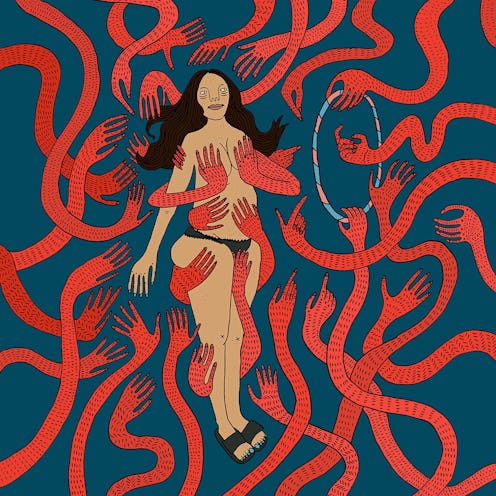Fashion
How Body-Posi Illustrations Made Me Love Myself

I’ve never really understood why, as a fat woman, fashion was never meant for me. Sure, I grew up ripping pages out of magazines and never once before the age of 18 (and the explosion of Fourth Wave feminism and the body positivity movement) did I see a single image that depicted my reality — not an isolated tummy roll, stretch mark, or slightly lumpy upper arm in sight. But for some reason, I disassociated those images of the mainstream fashion and beauty industries' depiction of perfection from what I saw in the mirror or what was purchasable. There may not have existed a publication depicting my own alleged imperfections, but there were certainly gals online drawing and creating illustrated notions of girlhood that rang far truer to how I lived my everyday life.
I have long dismissed mainstream campaign imagery as something of a fantasy; photographs produced in a faraway land that have no bearing on my everyday existence. However, as I grew up and my own feminist conscious began to become crystal clear — I started to see more problems with how the mainstream fashion industry at large operated.
As feminism moved away from a word used solely by my peers confined to Tumblr dashboards to an unavoidable topic of conversation within media, the arts, and the fashion industry, I started seeing more bodies that resembled mine. Yet I started feeling more marginalized in my body type than ever before.
You see, body positive campaigns and plus size photoshoots seem like more of a weekly occurrence than a rare gem these days. While it's been empowering on a personal level to see swimwear, underwear, and clothing championing the non-thin body ideal, or photo-stories showing off stretch marks, scars, and body hair loudly and proudly, these shoots still felt separate to 90 percent of the visuals appearing on my feeds. Within them, the identity of those like me often feels framed as a point of difference — as if my body is still being othered, even when being celebrated.
Instead, the type of visual representations that seemed to depict my identity as a plus size woman accurately continued to be those that were created using pen and paper: Drawings of larger ladies going about their everyday lives and sassy meme-style scribbles of big girls in booty shorts sipping on milkshakes. These are not framed as aspirational; nor are they framed as something "different." Instead, they depict the norm. The illustrations and illustrators whose work I double-tap across Instagram aren’t consciously using their work to smash down standards or push a radical agenda. They just seem to simply exist. Much like bodies like mine simply exist.
The work of artists such as Laura Callaghan, Frances Cannon, Mel Stringer, and Polly Nor is all consistently diverse. These women aren’t seemingly cashing in on the increasing popularity of the plus size movement to sell products. Rather, they are continuously representing their own worlds free from mainstream fashion industry standards and stereotypes.
Their work is not always presented as overtly political: It's not a grand statement about the world we live in. It just depicts elements of our lives that we can all relate to, sometimes presented through a fantastical gaze. Whether that’s Callaghan’s Millennial-inspired and insanely detailed scribbles of unpaid interns and Generation Y-specific problems, or Cannon’s line-drawn depictions of fat, queer love, these illustrations only seek to widen our definition of what it means to be plus size, rather than limit the definition further to the point of tokenization.
This isn't to say that I’m dismissing the radical potential of the visible fat body, or of imagery that depicts the plus size existence. Both can be hugely political. Photographers such as Lauren Crow and models like Paloma Elsesser provide the inspiring kind of plus size representation I continue to strive for and seek across all platforms.
But these figures are often the exception rather than the rule. Despite the often good intentions of "plus size" photography, campaign images, or photo series, it’s rare to find examples within the mainstream realm that move beyond the tokenization of our bodies. It's rare to find imagery that treats us as it would any other woman — any thin woman.
While I completely applaud other ladies who find liberation in these types of pictures, I can’t help but hope for a little more than a barely-there muffin top rolled by a large corporation whose sizing often doesn’t even stretch beyond a 14 in the name of diversity, self love, or body acceptance.
There’s power in photography, and that’s undeniable. But it’s arguably a power that has to be used with unapologetic force in order to make any tangible difference. For now, I’ll instead plaster my walls and my social media feeds with pretty pictures of plus size women drawn up entirely from someone else’s imagination. Because somehow, they seem far more real than the alleged reality I’m being sold elsewhere.
Image: Courtesy Polly Nor (1)